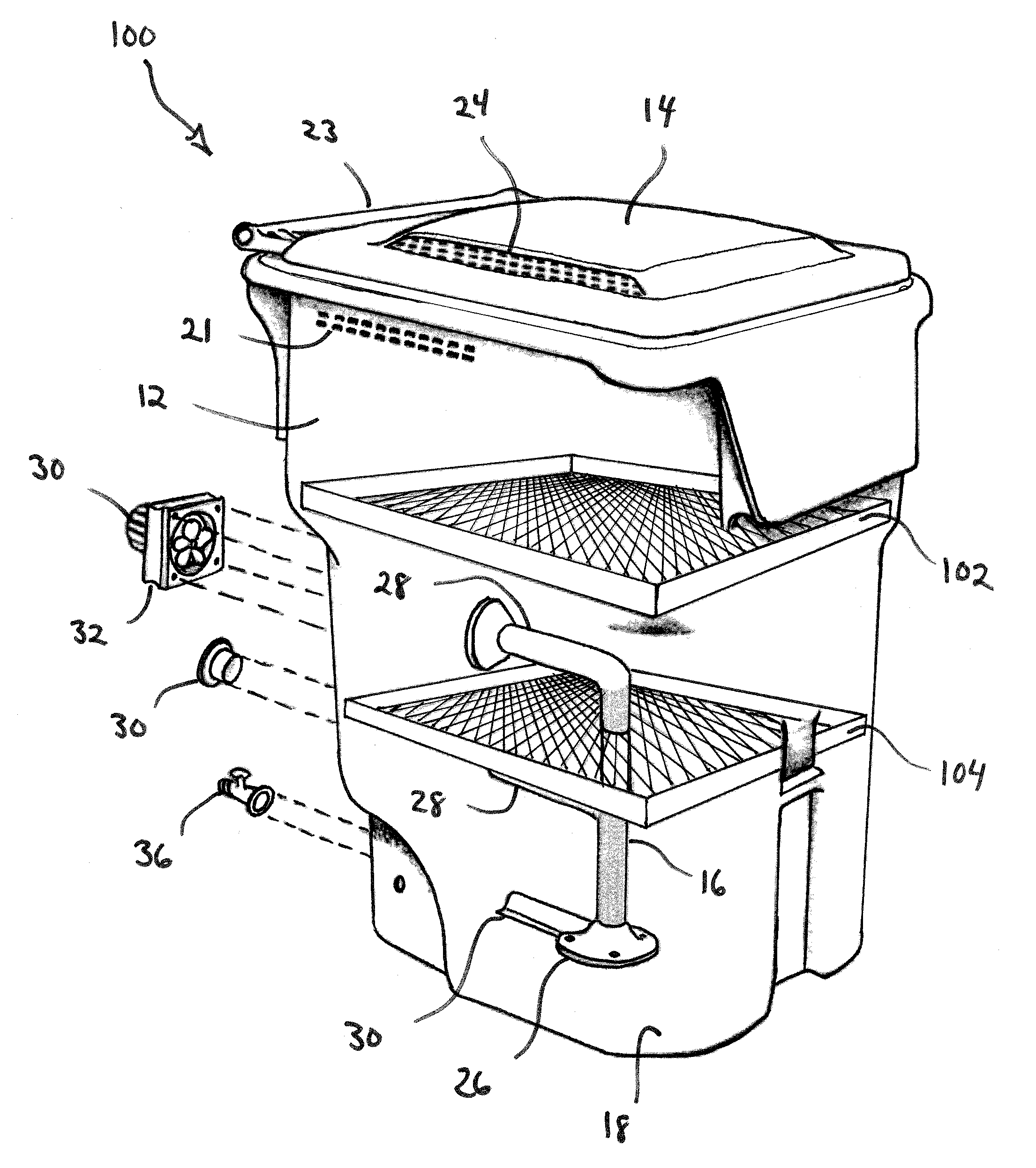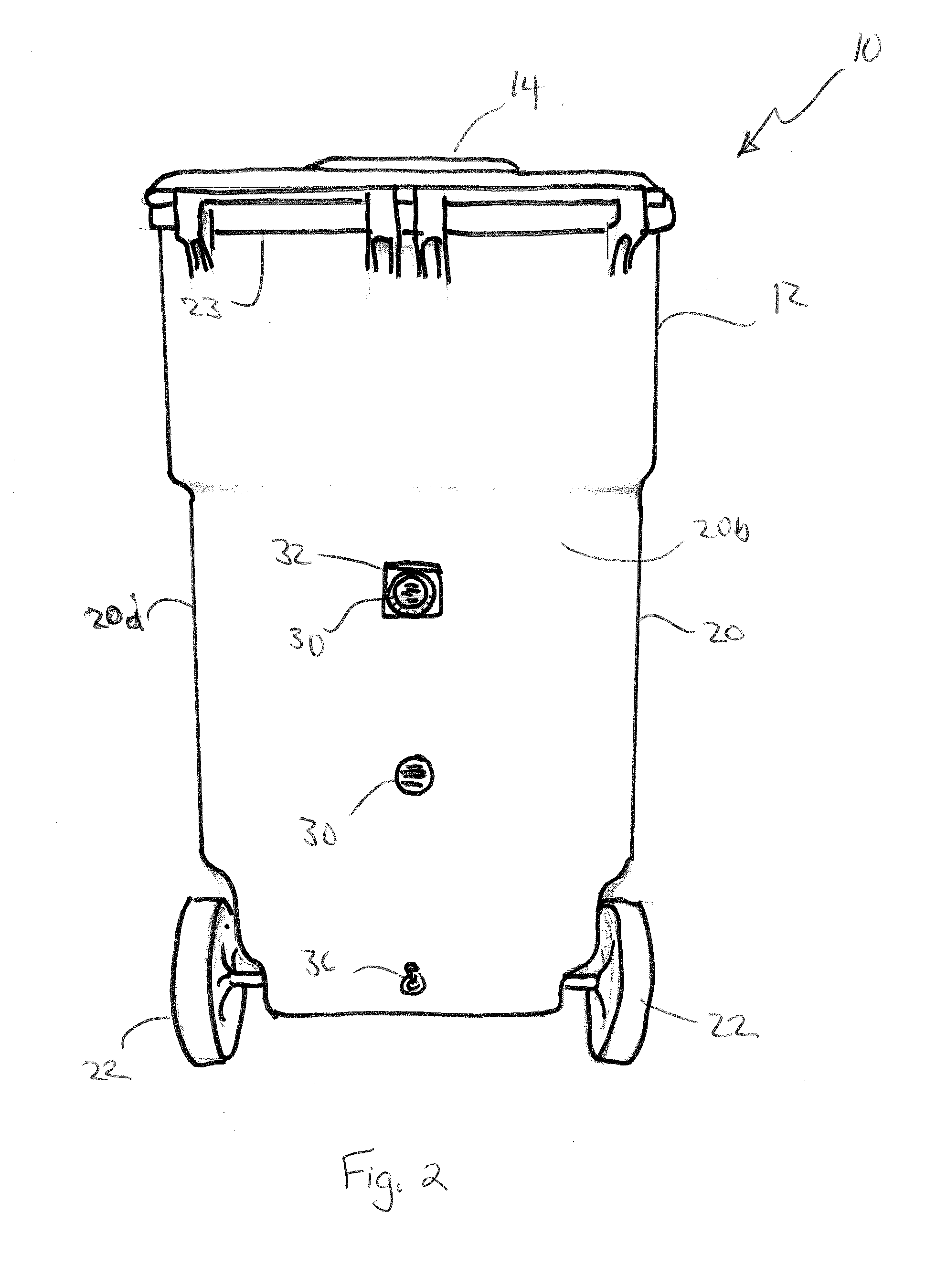Aerated composter and waste collection bin
a composter and bin technology, applied in bioreactors/fermenters, specific use bioreactors, products, etc., can solve the problems of releasing liquid, affecting the efficiency of air exchange, and affecting the quality of composting, so as to minimize or eliminate any leakage from the unit, efficient and thorough air exchange
- Summary
- Abstract
- Description
- Claims
- Application Information
AI Technical Summary
Benefits of technology
Problems solved by technology
Method used
Image
Examples
embodiment 100
[0035]Referring now to FIG. 3, a first alternative embodiment of the compost bin 10 is shown generally at 100. The first alternative embodiment 100 includes an optional first shelf 102 located above the perforated vent tube 16. The first shelf 102 includes a number of openings that function like a grate. That is, the composting material sit atop the first shelf and as the material decays and composts, it falls through the openings to the bottoms 18 below. The large particles of composting material remain above the first shelf 102 until it sufficiently decays enough to fall through the openings of the first shelf.
[0036]An optional second shelf 104 may be spaced below the first shelf 102. The second shelf 104 includes a number of openings that are smaller than the openings on the first shelf 102. The second shelf 104 functions in the same manner as the first shelf 102 in that the second shelf 104 functions as a sieve that allows only sufficiently composted materials to reach the botto...
embodiment 200
[0038]Referring now to FIG. 4, a second alternative embodiment is shown generally at 200. The second alternative embodiment 200 shows that the vent openings 30 may be located on the front 20a of the compost bin 10 in contrast to the preferred embodiment shown in FIGS. 1 and 2, where the vent openings 30 are on the rear 20b. Although not shown specifically, the vent openings 30 may also be located on the sides as well.
embodiment 300
[0039]Referring now to FIG. 5, a third alternative embodiment is shown generally at 300. The third alternative embodiment 300 includes features of the first alternative embodiment and second alternative embodiments. Specifically the compost bin includes first and second shelves 102, 104 and forward facing vent openings 30.
[0040]Referring now to FIG. 6, a fourth alternative embodiment is shown generally at 400 that includes an access door 402 on the sidewall 20 of the body portion 12 of the compost bin 10. The access door 402 is fitted within two tracks 404 and slides upwards to reveal an opening 406 into the body portion 12 of the compost bin 10. The opening 406 is preferably located near the bottom 18 of the boy portion 12 to permit the user to easily access fully composted material for use as fertilizer.
[0041]Referring now to FIGS. 7a and 7b, a fifth alternative embodiment of the compost bin is shown generally at 500. In this fifth embodiment 500, the compost bin 10 includes a hin...
PUM
| Property | Measurement | Unit |
|---|---|---|
| gravity | aaaaa | aaaaa |
| weight | aaaaa | aaaaa |
| movement | aaaaa | aaaaa |
Abstract
Description
Claims
Application Information
 Login to View More
Login to View More - R&D
- Intellectual Property
- Life Sciences
- Materials
- Tech Scout
- Unparalleled Data Quality
- Higher Quality Content
- 60% Fewer Hallucinations
Browse by: Latest US Patents, China's latest patents, Technical Efficacy Thesaurus, Application Domain, Technology Topic, Popular Technical Reports.
© 2025 PatSnap. All rights reserved.Legal|Privacy policy|Modern Slavery Act Transparency Statement|Sitemap|About US| Contact US: help@patsnap.com



